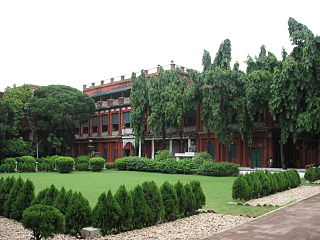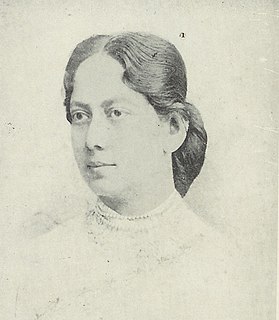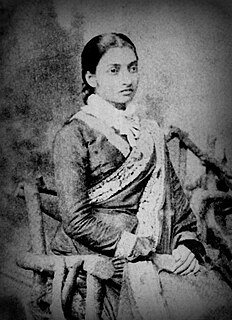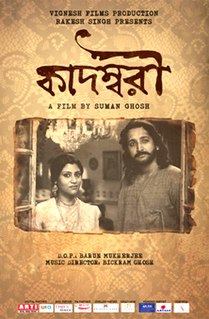Related Research Articles

Shantiniketan is a neighbourhood of Bolpur city in Bolpur subdivision of Birbhum district in West Bengal, India, approximately 165 km north of Kolkata. It was established by Maharshi Devendranath Tagore, and later expanded by his son Rabindranath Tagore whose vision became what is now a university town with the creation of the Visva-Bharati University.

Debendranath Tagore was a Bengali philosopher and religious savant, active in the Brahmo Samaj. He was the founder in 1848 of the Brahmo religion, which today is synonymous with Brahmoism. Born in Shilaidaha, his father was the industrialist Dwarkanath Tagore.

Gaganendranath Tagore was an Indian painter and cartoonist of the Bengal school. Along with his brother Abanindranath Tagore, he was counted as one of the earliest modern artists in India.

The first four decades in the life of Rabindranath Tagore (1861–1941) were formative of both his artistic and much of his political thinking. He was a Bengali poet, Brahmo philosopher, and scholar. His father Debendranath Tagore fought against the British soldiers.

Satyendranath Tagore was the first Indian to join the Indian Civil Service. He was an author, song composer, and linguist, and made a significant contribution towards the emancipation of women in Indian society during the British Raj. He was the second eldest brother of Rabindranath Tagore, the only Indian to get a Nobel Prize in Literature.
The Tagore family, with over three hundred years of history, has been one of the leading families of Calcutta, India, and is regarded as a key influence during the Bengal Renaissance. The family has produced several persons who have contributed substantially in the fields of business, social and religious reformation, literature, art and music.

Jorasanko is a neighbourhood of North Kolkata, in Kolkata district, West Bengal, India. It is so called because of the two (jora) wooden or bamboo bridges (sanko) that spanned a small stream at this point.
Ramanath Tagore, also spelled Roma Nath Tagore, was one of the leading social figures in 19th-century Kolkata, British India. The son of Rammani Tagore of the Jorasanko branch of the Tagore family, he was younger brother of Dwarkanath Tagore and a cousin of Prasanna Coomar Tagore. Later, he acquired the family property at Battala, one of the Kolkata neighbourhoods.
Gnanendramohan Tagore was the first Bengali, Indian or Asian to be called to the bar in England, in 1862.

Jyotirindranath Tagore was a playwright, a musician, an editor and a painter. Endowed with an outstanding talent, he had the rare capability of spotting talent in others. He played a major role in the flowering of the talents of his younger brother, the first non-European Nobel Prize winner, Rabindranath Tagore.
Dwarkin formally known as Dwarkin & Son, founded in 1875, was a pioneering Indian enterprise for the sale of Western and Indian musical instruments, which attained a legendary status in the music world at Kolkata, particularly with the development of the hand-held harmonium.

Manmohun Ghose was the first practicing barrister of Indian origin. He is notable for his contributions towards the fields of women's education, for arousing the patriotic feeling of his countrymen and for being one of the earliest persons in the country in organised national politics. At the same time his Anglicised habits often made him a target of ridicule in Calcutta.

Swarnakumari Devi was a poet, novelist, musician and social worker from the Indian subcontinent. She was the first among the women writers in Bengal to gain prominence.
Nabagopal Mitra was an Indian playwright, poet, essayist, patriot and one of the founding fathers of Hindu nationalism. He founded the Hindu Mela the pioneer institution behind the genesis of Hindu nationalism. Mitra also founded National Press, National Paper, National Society, National School, National Theatre, National Store, National Gymnasium and National Circus, earning him the sobriquet 'National Mitra'.
Tagore is the name of a prominent Bengali family of intellectuals, writers and artists, generally known as the Tagore family.

Jnanadanandini Tagore was a social reformer who pioneered various cultural innovations and influenced the earliest phase of women's empowerment in 19th century Bengal. She was married to Satyendranath Tagore, a scion of the Jorasanko Tagore Family.

Kadambari (2015) is a Bengali film directed by Suman Ghosh and produced by Rakesh Singh. The music of the film was composed by Bickram Ghosh. This is a biopic of Kadambari Devi, the sister-in-law of Rabindranath Tagore and Konkona Sen Sharma and Parambrata Chatterjee played the lead roles.

Pragyasundari Devi, also seen as Pragyasundari Debi, Pragya Sundari Devi, Pragasundari Debi, or Prajnasundari Bezbaroa, was an Indian cookbook author and magazine editor. Her Amish O Niramish Ahar was a "significant" early cookbook in the Bengali language.
Hindu Mela was a political and cultural festival started in 1867 in Calcutta. Its primary objective was to instill a sense of national pride among the city-dwellers to indigenous handmade products rather than imported British-made products. It included the display of swadeshi wrestling, swadeshi art and recital and performances of swadeshi poetry and songs. The mela met regularly until 1880 after which it lost its importance due to the establishment of other institutions.
Satyen Maitra was an educator, social worker, and a pioneer of mass education in India.
References
- 1 2 3 4 5 Sengupta, Subodh Chandra and Bose, Anjali (editors), 1976/1998, Sansad Bangali Charitabhidhan (Biographical dictionary) Vol I, (in Bengali), p. 127, ISBN 81-85626-65-0
- 1 2 Alam, Aksadul (2012). "Tagore, Gaganendranath". In Islam, Sirajul; Jamal, Ahmed A. (eds.). Banglapedia: National Encyclopedia of Bangladesh (Second ed.). Asiatic Society of Bangladesh.
- ↑ Bannerjee, Hiranmay, Thakurbarir Katha, (in Bengali), p.52 , Sishu Sahitya Sansad.
- ↑ Bannerjee, Hiranmay, family chart on p. 225.
- ↑ Bannerjee, Hiranmay, p. 6.
- 1 2 3 Bannerjee, Hiranmay, pp. 103-104.
- ↑ "Gaao Hey Taahaari Naam". Subinoy Roy. Inreco. Archived from the original on 9 October 2007. Retrieved 24 April 2007.
- 1 2 Deb, Chitra (1990). "Jorasanko and the Thakur Family". In Chaudhuri, Sukanta (ed.). Calcutta: The Living City. Volume I: The Past. Oxford University Press. pp. 65–66. ISBN 978-0-19-563696-3.
- ↑ Bannerjee, Hiranmay, p. 219.
- ↑ Mukhopadhyay, Ganesh (2012). "Theatre Stage". In Islam, Sirajul; Jamal, Ahmed A. (eds.). Banglapedia: National Encyclopedia of Bangladesh (Second ed.). Asiatic Society of Bangladesh.
- ↑ "The Tagores and society". Rabindra Bharati University. Archived from the original on 2 January 2008. Retrieved 24 April 2007.
- ↑ Sastri, Sivanath, Ramtanu Lahiri O Tatkalin Banga Samaj {Bn icon}, 1903/2001, p. 151, New Age Publishers Pvt. Ltd.
- ↑ Goswami, Karunamaya. "Music". amrakajon.org. Archived from the original on 21 March 2007. Retrieved 24 April 2007.